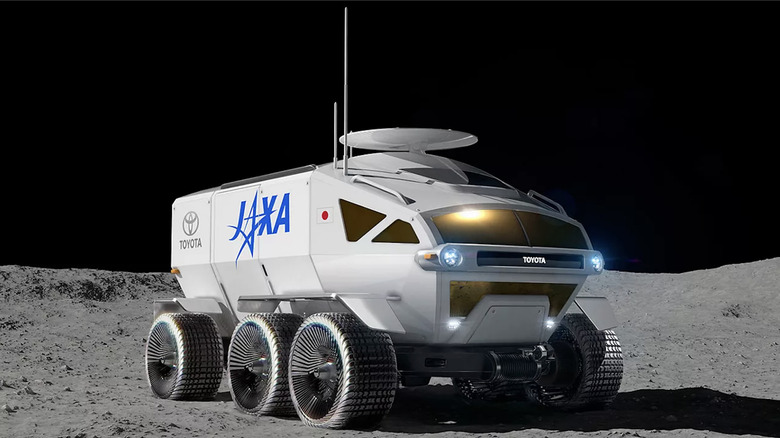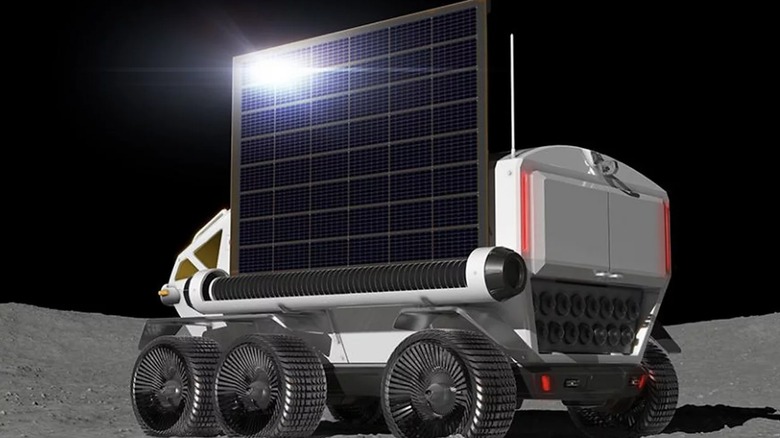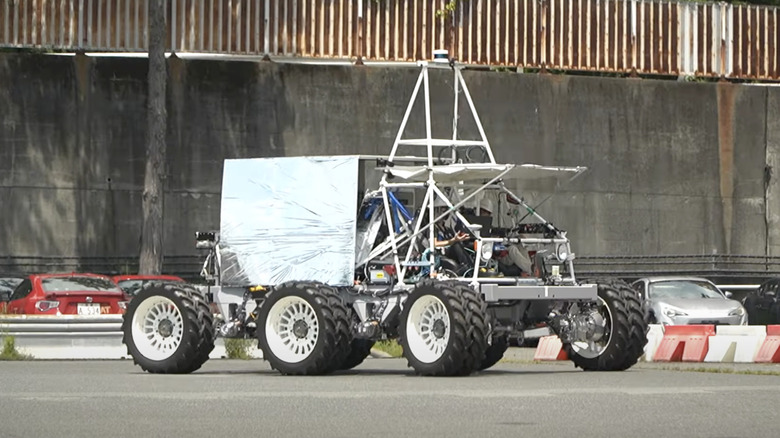Toyota Lunar Cruiser: What Does The Land Cruiser For The Moon Look Like?
Toyotas are ubiquitous — you'd be hard-pressed not to see at least one while driving on local roads or out the highway. One place you might not expect to see a Toyota, however, is on the surface of the Moon. But, if the Japan Aerospace Exploration Agency (JAXA) gets its way, that's exactly where you might find one, as it's currently working with Toyota to build a lunar cruiser specifically designed for exploring the unique conditions of Earth's satellite. The "Lunar Cruiser" project first began in 2019, and, if successful, will provide astronauts with an easier way to scout the surface of the Moon and explore larger areas beyond their landing site.
This wouldn't be the first vehicle to drive around the Moon's gray, sandy landscape. NASA's Lunar Roving Vehicle (LRV) was used during the last three Apollo missions conducted by NASA, which occurred in 1971 and 1972. The battery-powered vehicle could fit two astronauts and allowed astronauts to cover a distance of nearly 22.5 miles during Apollo 17 — the last time humans were on the Moon. NASA is currently working on Apollo's successor, the Artemis mission, which plans to bring people back to the Moon for the first time in over 50 years. Interest in further exploring the Moon has been steadily growing over the years, as the planetary body can be mined for resources and is a perfect place for a giant lunar telescope.
Toyota's Lunar Cruiser will look sleeker and more modern. Its six large wheels and squat frame give it sort of a bug-like appearance, though you wouldn't be wrong to compare it the brand's Land Cruiser. Its boxy design looks even closer to Toyota's camper vans, though. That makes sense, because astronauts won't just drive the vehicle — they'll also live in it.
Toyota's Lunar Cruiser will be habitable
Unlike both NASA's original and 21st-century lunar rovers, which are open-air and require passengers to keep their astronaut suits on, the Toyota Lunar Cruiser will be closed and pressurized. That means passengers could take off their suits and inhabit the cruiser just as they do in most spacecraft. Designed to be habitable for several weeks at a time, the Lunar Cruiser will serve not just as a means of transportation but also as a home for those exploring the Moon. For the sake of the inhabitants' mental health, Toyota is trying to make the vehicle, which will likely hold 2-4 passengers, as spacious as possible. The cruiser will also employ automated systems, including self off-road driving, for the sake of the astronauts as well.
Toyota makes some of the best off-road vehicles you can buy, but a lunar cruiser wouldn't just be off-road — it would be off-planet. In addition to handling uneven, unpredictable terrain, any vehicle on the Moon also needs to contend with factors like lower gravity and the fact that there won't be any gas stations or body shops nearby to tow it in an emergency. Its large airless tires, which are being developed by Bridgestone Corporation, will consist of metal rather than rubber to better handle lunar terrain. Rubber and resin materials are also more susceptible to damage from the higher levels of radiation present on the Moon's surface.
Other factors that need to be considered by Toyota as they build the Lunar Cruiser include withstanding extreme hot and cold temperatures, roll-over protection from uneven terrain (and craters), safe route generation, radio signal navigation, and driving controls that keep astronauts as safe as possible from accidents. For the latter, Toyota will include a superimposed heads-up display for driving assistance.
The Lunar Cruiser currently looks different than its final version will
JAXA and Toyota expect the Lunar Cruiser to launch in 2029, and the vehicle could see refinements to its design before then. Much of its construction is complete, though, and the Toyota Lunar Cruiser has already completed test runs. So far, it has managed a top speed of 10 km/h (6.2 mph) and achieves a 10 m (33 ft) turning circle. It has also been assessed on another Toyota test track designed to create Moon-like conditions, with stones and even a fairly large crater. One major difference between how the Lunar Cruiser currently looks and how it eventually will look is that it currently has an open-air frame with no doors, walls, or windows, which would be deadly to anyone driving it on the Moon without a pressurized spacesuit.
But the technologies being developed and fine-tuned by JAXA and Toyota for the Lunar Cruiser are likely to also have applications closer to home. Toyota says that the sensors and automated systems of the vehicle may one day be used for remote scanning in hazardous or impossible-to-reach disaster areas and other dangerous zones. Additionally, the power systems being designed for the cruiser may be adapted for more efficient H2 power on Earth.
Hydrogen power produced through electrolysis is sustainable and carbon-friendly. Its byproduct is heat and water rather than CO2, and Toyota's innovations may end up being used by car companies currently developing hydrogen-powered vehicles. Plus, advanced H2 power could also one day be used for remote towns, refugee camps, and other communities not drawing power from the grid. By pushing technology forward both on Earth and the Moon, the Toyota Lunar Cruiser may prove to be one small drive for man, one giant road trip for mankind.


